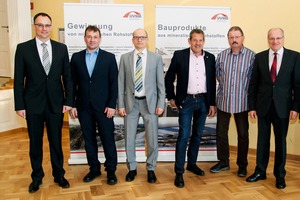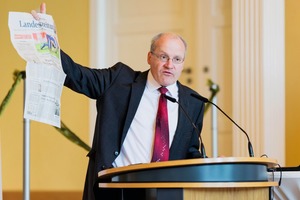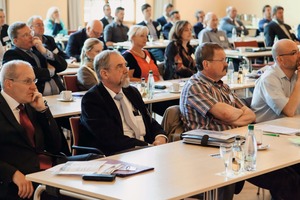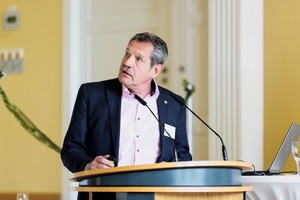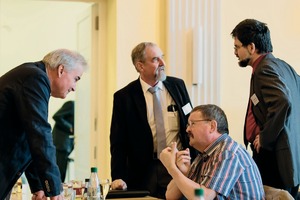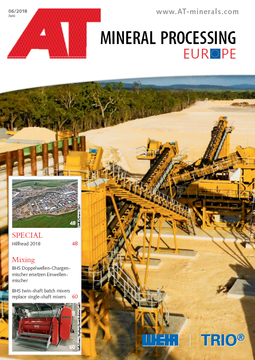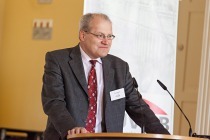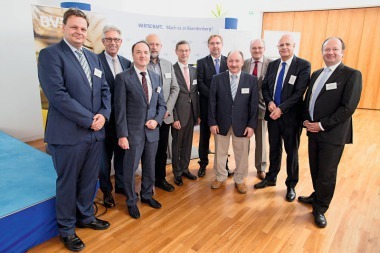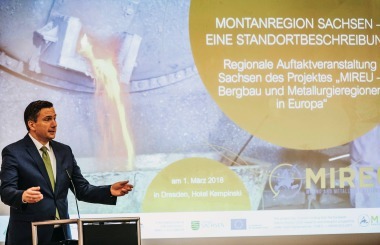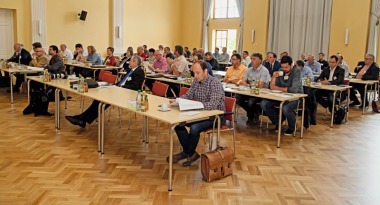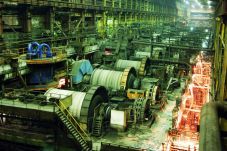17th Mineral Resources Colloquium in Schönebeck
“Mineral-resources policy is no longer a marginal topic in the new coalition agreement,” announced UVMB director Bert Vulpius in his introduction - good news for the industry. Movements are also taking place in the recycling of mineral waste, as he noted. The “umbrella ordinance”, which is intended to regulate the recycling of mineral waste and the production of recycled building materials on a Germany-wide basis, has also managed to gain inclusion in the new federal government’s coalition agreement.
The plans for administrative reforms in Thuringia are currently causing great worries for the confederation: the state’s Mining Bureau is to lose its independence under these plans. “We, as an industry, fear that the administrative reform will be exploited for environmental-policy regulations on industry that will be not in the interest of the state, but will, instead, pursue party-political considerations.” The daily press in Thuringia has now also taken up this subject, and has made its position clear, the UVMB director continued.
Dr. Gunther J. Rieger, of the “Rechtsanwälte Dr. Dammert & Steinforth” firm of attorneys, reported on a “constitutionality assessment” against the regional plan for North Thuringia. The background to this, he stated, is the legal action by two companies whose planned mining projects have been overruled in favour of priority zones for safeguarding of open space, thus excluding any utilisation for mining purposes. The Thuringian Higher Administrative Court in its verdict announced in December 2017 has declared the corresponding provisions of the regional plan concerning the priority zones for the safeguarding of open space to be null and void. As a consequence of this verdict, Dr. Rieger advises such companies to engage in the regional-planning process with qualified and well-founded objections, in order thus also to represent their own business interests with a view to assessment by the courts. “No relevant information should be withheld.” Such information includes, inter alia, a detailed exposé of the implications, the operational necessities involved in securing deposits and the economic effects on the region and on jobs, Dr. Rieger continued.
The assessment of environmental impact as an inseparable element in the approval procedure plays an important role in project planning. Last year’s amendment to the EIA Act implemented requirements originating from the European Union and from recent legal decisions. The old EIA Act was, in many cases, only poorly comprehensible, and included numerous questionable compromises, which the amendment has now eliminated. This Act has now become clearer, more “user-friendly”, and also more easily comprehensible for non-lawyers, affirmed Dr. Jochen Ritter, departmental head at the Federal Ministry for Environment, Nature Conservation and Nuclear Safety. There are now, for example, clear stipulations concerning the duration of a preliminary EIA, which were previously lacking, and are intended to assist in accelerating such procedures.
The amendment also adds extra value to the Environmental Impact Assessment. Observations on the cumulative effects of projects are new elements in this Act. In “Land” a new endangered-asset category previously not present has been incorporated into the Act. In addition, the EIA report, EIA-relevant appraisals and approval decisions are to be made accessible to the public in electronic form in order to attain greater transparency. Central federal and federal-state EIA portals have been created for this purpose.
The extraction of mineral resources and biodiversity are not mutually exclusive - this was the conclusion drawn by Oliver Fox. This university-qualified biologist has been employed by the UVMB as a consultant for the environment and biodiversity for around two years. He cited impressive practical examples to demonstrate how biodiversity in mining has now, thanks to systematic provisions, become normality. In the Leipzig region, for example, young ringed birds from two open-cast mines were registered on the Atlantic coast of western Europe last year. “Here, biodiversity in our open-cast operations can be seen to be attaining supra-regional, and even European, significance,” Fox added. The aim is that of optimally utilising the potential of every mining location for the purposes of biodiversity without imposing any restrictions on mining operations. “In particular, smaller bodies of water either resulting from mining or specifically created have great importance for the retention of native species of amphibians,” as Fox illustrated with his examples. In cooperation with nature-conservation partners, the UVMB has initiated in the German federal states of Thuringia and Saxony state-wide projects for the protection of amphibians, and these are to be developed further in the coming years.
An “Open Day” can assist in creating acceptance and trust within the region. This was the experience impressively communicated by Jürgen Witter, a director of Quarzsand GmbH Nudersdorf. As long ago as 2004, the company held its first open day - at a time at which many companies still took a more sceptical stance with regard to such events. Quarzsand GmbH Nudersdorf has since then continued to hold such open days periodically. As Witter noted, good planning and preparation are of great importance. The necessary organisational work and costs for such events, he remarked, are of rational magnitudes. The involvement of regional players, local associations and other influencing persons and bodies has also proven its value in practice. “In addition to our local heritage association, we also approached the German Social Accident Insurance Institution for the Raw Materials and Chemical Industry. This was very well received, and we were, ultimately, surprised by the great interest aroused in the region. The daily press also responded well to our event,” Witter reported.
The Federal Institute for Geosciences and Natural Resources, based in Hanover, in February 2018 issued a publication well regarded throughout Germany under the title of “Sand - soon to be a scarcity in Germany, too?” concerning shortages of building resources such as sand and gravel. Pierre Neumann, director of Havelbeton GmbH & Co. KG, a ready-mixed concrete producer active in the Berlin region, illustrated just how acute these shortages have already become in practice. The quantities of ready-mixed concrete demanded by the market could not be produced, and delivery times amounting in some cases to more than fourteen days arose, construction projects were delayed, and building costs rocketed skywards. “Some politicians suffer from the illusion that the universal use of recycled materials could provide a solution to this problem - but here, too, there is a great chasm between supply and demand.” Neumann appealed to the politicians to create dependable boundary conditions which would assure supplies of these resources. “The times needed for approval procedures for extraction of mineral resources are totally unacceptable and are in no way reconcilable with social demands for new residential capacities and the expansion of the infrastructure,” Neumann concluded.

